How Do Cardinal Tetras Lay Eggs?
Yes, Cardinal Tetras lay eggs. They're oviparous and require specific breeding conditions to thrive.
Guarantee the water is soft, acidic (pH 5.5-6.5), and maintain a temperature of 75-80°F. Dim lighting and fine-leaved plants are essential as females scatter sticky eggs, which males fertilize immediately.
Keeping the water clean and reducing light exposure are critical for egg and fry survival. You can identify males by their vibrant colors and courtship behavior, while females have rounder bellies.
To successfully breed Cardinal Tetras, consider these requirements and see what else you might need for a thriving tank setup.
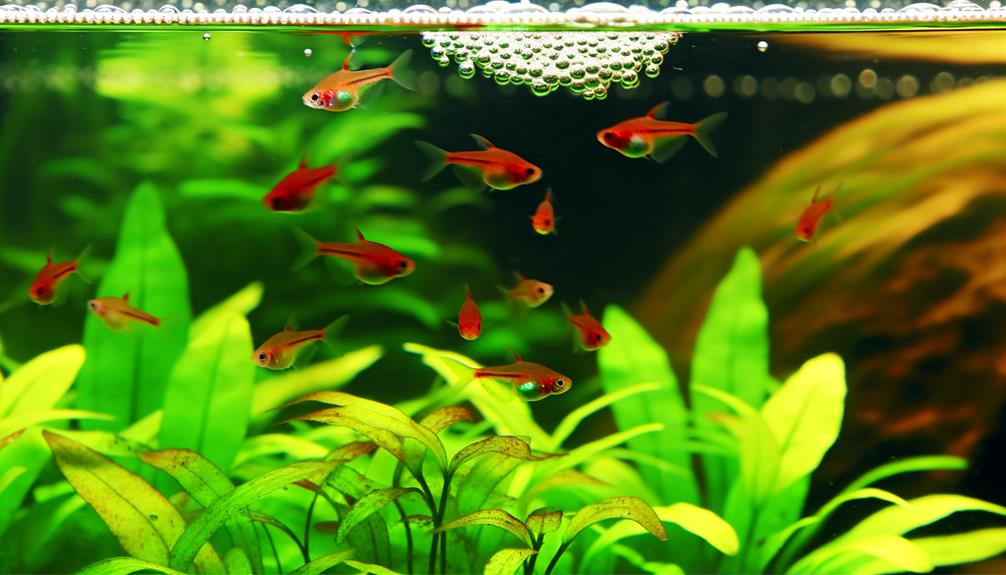
Key Takeaways
- Cardinal Tetras are oviparous and lay eggs.
- Females scatter adhesive eggs over fine-leaved plants.
- Spawning requires soft, acidic water and dim lighting.
- Males fertilize the eggs immediately upon release.
- Eggs need clean water and reduced light exposure for protection.
Cardinal Tetra Reproduction Basics
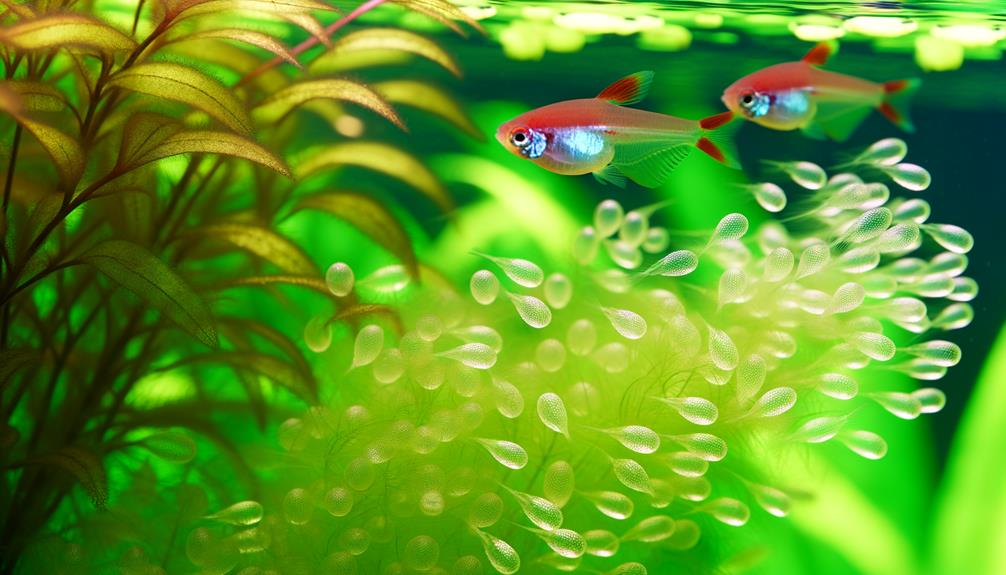
Understanding the reproduction basics of Cardinal Tetras involves recognizing their egg-laying behavior and specific breeding conditions. You need to know they're oviparous, meaning they lay eggs rather than giving birth to live young.
Excellent breeding conditions require soft, acidic water with a pH between 5.5 and 6.5 and temperatures around 75-80°F. Dim lighting helps mimic their natural habitat, encouraging spawning. Females scatter hundreds of adhesive eggs over fine-leaved plants or spawning mops.
Fertilized eggs hatch in about 24-36 hours. You should maintain water cleanliness and reduce light exposure to protect the eggs and fry from potential fungal infections and predation. By understanding these specific parameters, you can effectively facilitate the breeding of Cardinal Tetras in captivity.
Male Vs. Female Identification
Identifying male vs. female cardinal tetras involves examining their physical appearance and behavioral traits. Males generally exhibit brighter coloration and a slimmer body profile, while females are more robust and have a fuller abdomen, especially during the breeding season.
Observing these differences will help you accurately determine the sex of your cardinal tetras, which is essential for successful breeding.
Physical Appearance Differences
When trying to differentiate between male and female Cardinal Tetras, you'll notice that males typically have a slimmer body and more vibrant coloration compared to the rounder and slightly duller females. Males exhibit a more pronounced red stripe, extending from their gill covers to the base of their caudal fins.
Females, on the other hand, have a more pronounced belly, especially noticeable when they're gravid. The blue stripe on females often appears less intense, providing a subtle visual cue for sex identification. Additionally, in well-maintained environments, males' streamlined bodies and brighter hues become even more apparent.
Behavioral Traits Comparison
In addition to physical differences, male and female Cardinal Tetras exhibit distinct behavioral traits that can aid in their identification, particularly during courtship and breeding rituals.
Males often display more vibrant coloration and engage in elaborate courtship displays, including rapid swimming patterns and fin flaring to attract females.
Females, on the other hand, tend to exhibit more subdued colors and show increased foraging behavior to build energy reserves for egg production.
During spawning, you'll notice females depositing eggs on plant leaves or substrate, while males follow closely to fertilize them.
Observing these behaviors can provide a reliable method for distinguishing between sexes in a natural or controlled environment, facilitating successful breeding and maintenance of aquarium populations.
Optimal Breeding Conditions
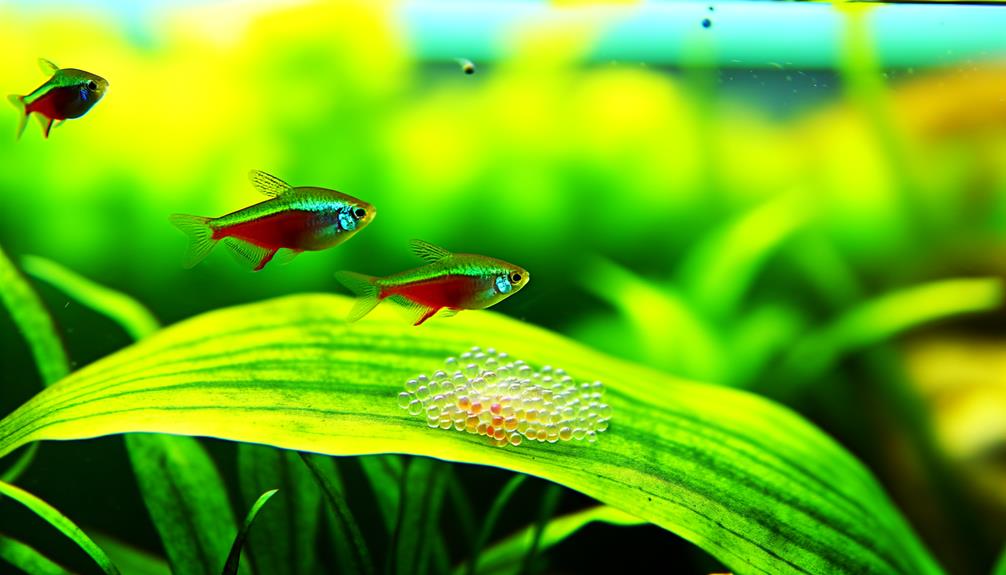
To guarantee successful breeding of Cardinal Tetras, you need to maintain water temperatures between 75-80°F, as this range optimizes reproductive activity.
Implement a consistent light and darkness cycle, ideally with 12 hours of light followed by 12 hours of darkness, to mimic their natural habitat and stimulate spawning behavior.
Studies show that adherence to these conditions notably boosts egg production and hatch rates.
Water Temperature Requirements
Maintaining a water temperature between 75°F and 80°F is important for maximizing the breeding conditions of Cardinal Tetras. You'll need to make sure your aquarium heater is accurate, as even slight fluctuations can impact breeding success. Evidence suggests that this temperature range promotes ideal metabolic rates and enhances egg viability.
Monitoring the temperature with a dependable thermometer is key; consistency is your ally here. Aim for the lower end of the range during initial conditioning, gradually increasing to the higher end to stimulate spawning. If you deviate outside this range, you risk increased stress levels and reduced fertility.
Light and Darkness Cycle
Besides maintaining ideal water temperatures, ensuring a balanced light and darkness cycle is crucial for the breeding success of Cardinal Tetras.
You should provide 10-12 hours of light daily, mimicking their natural habitat. Too much light can stress the fish and inhibit spawning, while insufficient light disrupts their daily rhythms. Use a timer to automate the cycle, ensuring consistency.
Studies show that gradual changes between light and darkness prevent stress-induced behaviors. Incorporate dim lighting during dawn and dusk periods to replicate the natural environment. This approach fosters a stable breeding atmosphere, promoting egg-laying activities.
Water Quality Requirements
Proper water quality is crucial for the health and breeding success of Cardinal Tetras. This necessitates specific parameters such as pH levels between 5.5 and 7.0 and a temperature range of 73-81°F.
You must maintain soft water conditions, ideally with a hardness of 1-4 dGH, to replicate their natural Amazonian habitat. Regular water changes, around 20-30% weekly, will help in reducing nitrate levels, which should stay below 20 ppm.
Ensure your filtration system supports biological filtration, promoting the nitrogen cycle to keep ammonia and nitrite levels at zero. Monitor dissolved oxygen levels closely, aiming for saturation above 80%.
High-quality water not only boosts their immune system but also notably increases spawning frequency and egg viability.
Setting Up the Breeding Tank
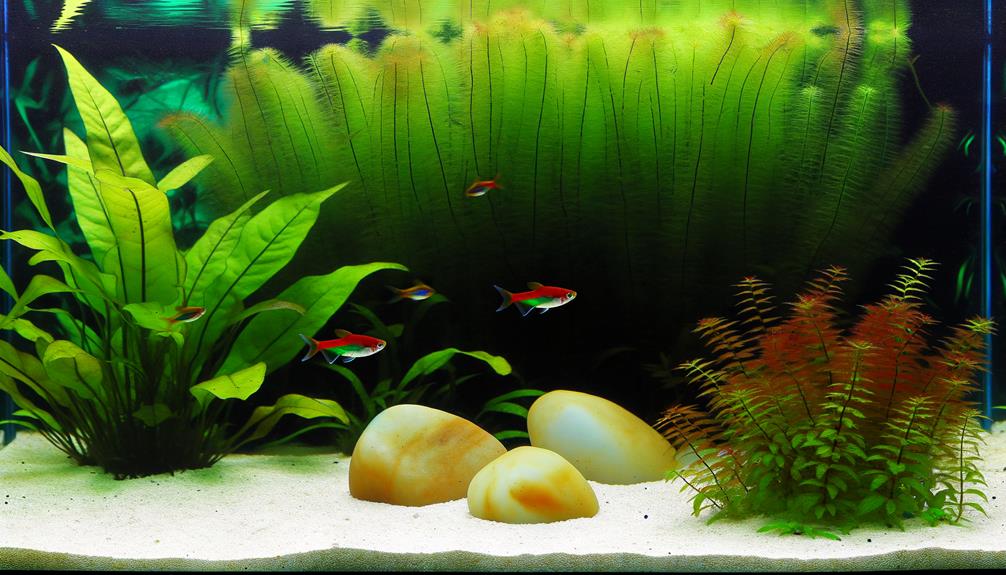
To guarantee successful breeding of cardinal tetras, you should establish ideal tank conditions, including maintaining soft, acidic water with a pH of 5.5 to 6.5.
Water quality parameters like temperature should be consistently around 75-80°F to mimic their natural habitat.
Additionally, selecting appropriate tank mates is vital, as aggressive species can stress the tetras and disrupt the breeding process.
Optimal Tank Conditions
Maintaining ideal tank conditions is crucial for successful breeding of Cardinal Tetras, necessitating precise control over water parameters, lighting, and substrate. First, make sure the tank is dimly lit to replicate their natural habitat. Utilize a soft, fine substrate to safeguard sensitive eggs.
Setting up the tank:
| Parameter | Ideal Condition |
|---|---|
| Lighting | Dim, subdued |
| Substrate | Soft, fine |
| Tank Size | 10-20 gallons |
| Plants | Dense, live plants |
| Temperature | 75-82°F (24-28°C) |
Dense, live plants like Java moss provide essential cover for eggs. A 10-20 gallon tank offers ample space without overwhelming them. By establishing these conditions, you're creating an environment where Cardinal Tetras can thrive and breed successfully.
Water Quality Parameters
How do you optimize the water quality parameters for breeding Cardinal Tetras, focusing on parameters like pH, hardness, and ammonia levels?
First, the pH is slightly acidic, ideally between 6.0 and 6.5. This mimics their natural Amazonian habitat. Water hardness should be kept soft, around 1-4 dGH, to encourage spawning.
Ammonia levels must be undetectable; use biofiltration to maintain this. Regularly test water parameters using reliable kits. Adjust as necessary with peat filtration to lower pH and soften water. Avoid chemicals that could stress the fish.
Consistent water temperature around 75-80°F (24-27°C) is crucial. These precise conditions provide a conducive environment for Cardinal Tetras to lay eggs, enhancing your chances of successful breeding.
Suitable Tank Mates
Establishing optimal water quality parameters sets the stage for choosing appropriate tank mates that won't disrupt the delicate breeding conditions of Cardinal Tetras. You need to select non-aggressive, small fish that flourish in similar water conditions. Avoid large or predatory species that might consume the eggs or stress the breeding pairs. Ideal companions include small catfish and shrimp that help maintain tank cleanliness without harming the tetras.
| Appropriate Tank Mates | Characteristics |
|---|---|
| Otocinclus Catfish | Peaceful, algae-consuming fish |
| Cherry Shrimp | Non-aggressive, scavenging crustaceans |
| Corydoras | Gentle, bottom-dwelling species |
| Neon Tetras | Compatible, similar in size |
| Amano Shrimp | Algae management, harmless |
Choosing the right companions ensures a harmonious environment, crucial for successful breeding.
Spawning Behavior
When conditions in the aquarium replicate their natural habitat, cardinal tetras exhibit specific spawning behaviors characterized by synchronized swimming and egg scattering. You'll notice that males and females engage in a delicate courtship dance, often swimming in tight, coordinated patterns. This behavior is a precursor to spawning, indicating that tetras are ready to reproduce.
Studies show that dim lighting and slightly acidic water with a pH between 5.5 and 6.5 optimize their spawning activity. Additionally, the presence of fine-leaved plants or spawning mops provides ideal surfaces for egg scattering.
Egg Laying Process
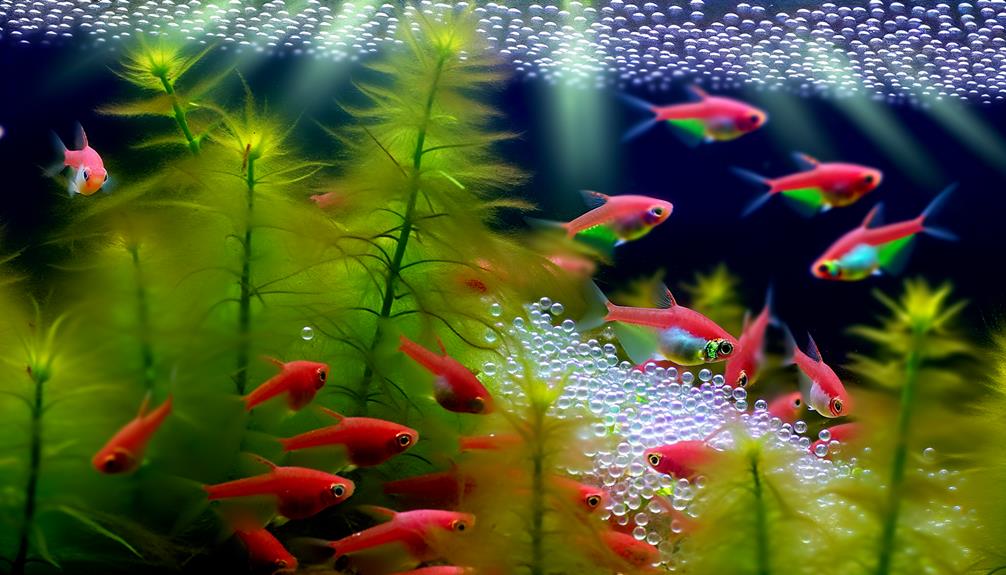
The egg-laying process of cardinal tetras involves the female dispersing hundreds of sticky eggs across fine-leaved plants or spawning mops, where they'll adhere and start development. You'll notice that this dispersal isn't random; the female targets ideal surfaces that guarantee maximum egg attachment and protection.
During this period, the male follows closely, fertilizing the eggs immediately as they're released. The sticky nature of the eggs allows them to adhere firmly to the plants, reducing the risk of drifting away. These conditions mimic their natural habitat, where dense vegetation provides a secure environment.
This method ensures the eggs' survival and proper development, utilizing the plants' structure to create a stable and favorable growth environment.
Protecting the Eggs
Protecting the eggs involves maintaining ideal water conditions and minimizing disturbances to ensure successful hatching. Keep the water temperature between 75-80°F and maintain a pH level around 6.0-6.5. Soft water, with a hardness of 1-2 dGH, is essential.
Perform regular but gentle water changes to reduce ammonia and nitrite levels. Use a sponge filter to provide gentle water circulation without creating strong currents that might dislodge the eggs. Dim the lighting, as excessive light can stress the eggs.
Add plants or spawning mops to provide cover, reducing predation risks. Avoid unnecessary tank movements and loud noises that could cause vibrations. By carefully managing these environmental factors, you'll optimize the chances of successful egg protection and subsequent hatching.
Hatching the Fry
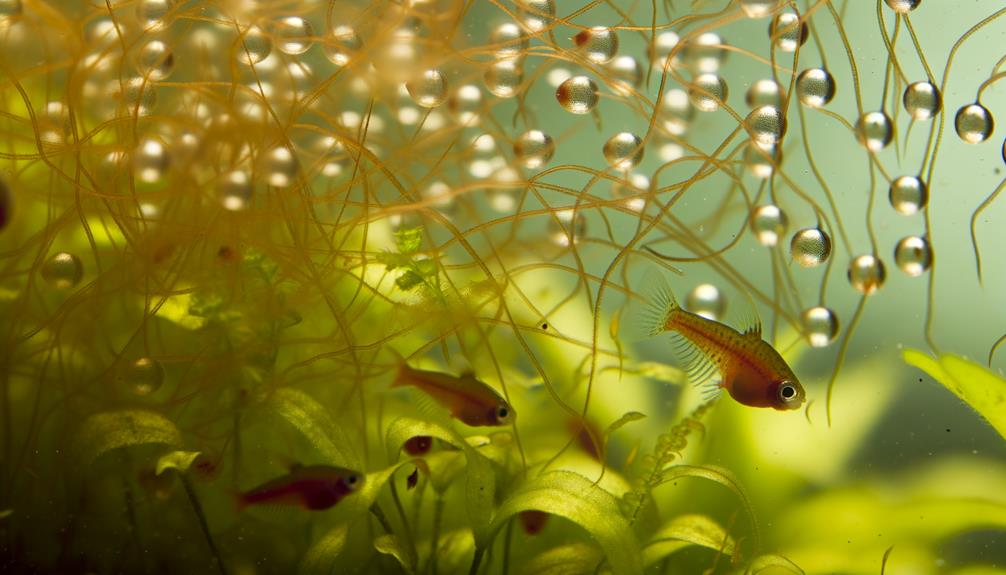
Maintaining a stable temperature between 75-80°F is essential for guaranteeing the successful hatching of cardinal tetra fry. Research indicates that temperature fluctuations can lead to developmental issues or even failure to hatch. Invest in a reliable aquarium heater with a precise thermostat.
Additionally, make sure the water's pH remains between 5.5-6.5, as this range closely mimics their natural habitat, promoting ideal hatching conditions. Provide low lighting to reduce stress and avoid predation risks.
Use an air-driven sponge filter to maintain clean water without creating strong currents that could disturb the delicate eggs. Consistent monitoring and adjustments will maximize your chances of successful hatching, empowering you to cultivate a thriving cardinal tetra population.
Feeding the Fry
Optimizing proper nutrition for cardinal tetra fry begins with providing high-quality infusoria or commercially available liquid fry food, which are crucial for their initial development.
You'll need to feed them multiple times a day, as frequent, small feedings support prime growth rates.
As the fry grow, gradually introduce finely crushed flake foods and baby brine shrimp. This shift guarantees they receive a balanced diet rich in proteins and essential nutrients.
Evidence shows that maintaining consistent feeding schedules and monitoring their growth closely enhances survival rates.
Remember, water quality is paramount; uneaten food can quickly degrade water conditions, so siphon out any excess after feeding.
Prioritize a clean environment to prevent disease and promote healthy development.
Common Breeding Challenges
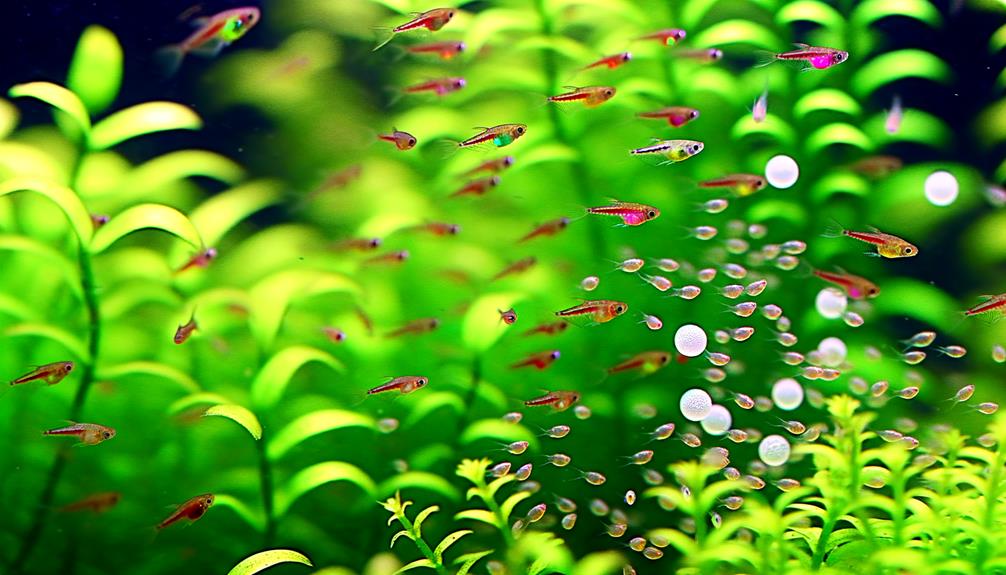
Breeding cardinal tetras presents several challenges, primarily due to their specific water parameter requirements and the need for precise environmental conditions. You'll need to maintain soft, acidic water with a pH between 5.0 and 6.0, and a temperature around 75-80°F.
Additionally, ensuring low light levels is pivotal as their eggs are highly sensitive to light. Another obstacle is providing an ideal spawning substrate, such as fine-leaved plants or spawning mops.
Successful breeding also demands separating adults from the eggs immediately after spawning to prevent predation. Consistent monitoring and adjustments to water quality are essential for optimizing breeding conditions, as even minor deviations can disrupt the process.
Overcoming these challenges requires meticulous attention and dedication to detail.
Conclusion
To sum up, breeding cardinal tetras demands exact conditions and meticulous attention to detail.
Did you know that a single female can lay up to 500 eggs?
This emphasizes the significance of setting up an ideal breeding tank and maintaining excellent water quality.
Safeguard the eggs diligently to guarantee a high hatching success rate.
With adequate care and feeding, you'll observe the captivating transformation from small eggs to colorful fry, making the endeavor worthwhile.






